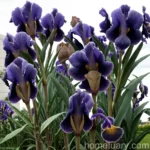Dalmatian Iris (Iris pallida ‘Dalmatica’) – A Complete Guide
Iris pallida ‘Dalmatica’ is a stunning flowering plant that belongs to the family Iridaceae. These beautiful perennials are native to the Dalmatian coast in Croatia, and they are known for their striking flowers and exceptional fragrance. In this comprehensive guide, we will explore the cultivation, care, and various uses of the Dalmatian iris, providing valuable insights for both novice and experienced gardeners.
What is the Dalmatian Iris (Iris pallida ‘Dalmatica’)?
The Dalmatian iris, scientifically known as Iris pallida ‘Dalmatica’, is a herbaceous perennial plant that typically grows to a height of 2-3 feet. Its foliage consists of narrow, sword-shaped leaves that form an attractive clump, while its flowers are characterized by exquisite colors and a delightful fragrance. The blooms of the Dalmatian iris are typically shades of blue and purple, although some varieties may also display white or lavender hues.
Key Takeaways
Before delving into the specifics of Dalmatian iris cultivation, it’s important to highlight the key takeaways regarding its care and characteristics. Here are some essential points to keep in mind when considering the Dalmatian iris:
- Cultivation: Dalmatian iris requires well-drained soil and a sunny location to thrive.
- Uses: This plant is commonly used for ornamental and landscaping purposes, thanks to its vibrant flowers and pleasant fragrance.
- Water: It prefers moderate watering and should be protected from excessive moisture to prevent root rot.
- Sunlight: Dalmatian iris thrives in full sun and requires at least 6-8 hours of sunlight daily.
- Fertilizer: Light fertilization is recommended to support healthy growth and blooming.
- Soil: Well-drained, slightly alkaline soil is ideal for Dalmatian iris cultivation.
Now, let’s delve deeper into each of these aspects to gain a comprehensive understanding of how to cultivate and care for Dalmatian iris.
Cultivation of Dalmatian Iris
Water
Dalmatian iris plants have moderate water needs and should be watered regularly, especially during the drier months. However, it is important to avoid overwatering, as excessive moisture can lead to root rot and other issues. As a general rule, the soil should be kept consistently moist but not waterlogged. During long dry spells, watering deeply once a week should be sufficient for established plants.
Sunlight
Dalmatian iris plants thrive in full sun, meaning they require at least 6-8 hours of direct sunlight daily to bloom prolifically. While they can tolerate some partial shade, insufficient sunlight may result in reduced flowering and overall weaker growth. Therefore, it is essential to select a planting location that receives ample sunlight to ensure the plant’s vitality and vibrancy.
Fertilizer
When it comes to fertilizing Dalmatian iris, a light touch is key. Applying a balanced, slow-release fertilizer in early spring as new growth emerges can provide the necessary nutrients to support healthy development and abundant flowering. A 10-10-10 fertilizer or similar balanced formulation can be applied according to the manufacturer’s instructions. Avoid excessive fertilization, as it may lead to lush foliage at the expense of flower production.
Soil
The Dalmatian iris thrives in well-drained, slightly alkaline soil. Amending the soil with organic matter such as compost or well-rotted manure can improve its texture and drainage, creating an optimal growing environment for these plants. Additionally, a slightly elevated planting area or raised bed can help prevent waterlogging and ensure that excess moisture does not adversely affect the roots.
Pruning Dalmatian Iris
Pruning is an essential aspect of Dalmatian iris care, as it helps maintain the plant’s health and appearance while promoting robust flowering. The following guidelines can help you effectively prune your Dalmatian iris plants:
- Deadheading: Removing spent flowers promptly not only enhances the plant’s aesthetic appeal but also prevents the seeding process, redirecting the plant’s energy back into vigorous growth and future blooming.
- Foliage Removal: Trimming back any damaged or yellowing foliage can improve the plant’s overall appearance and reduce the risk of disease and pest issues.
Propagation
Dalmatian iris can be propagated through several methods, including division, seed propagation, and rhizome cuttings. However, division is the most common and reliable technique for reproducing these plants. Here’s a brief overview of how to propagate Dalmatian iris through division:
- Timing: The ideal time to divide Dalmatian iris is in late summer or early fall, allowing the plants to become established before the onset of winter.
- Dividing the Rhizomes: Carefully lift the clumps of iris plants from the ground and separate the rhizomes, ensuring that each division possesses healthy roots and a viable growing point.
- Replanting: Plant the divided rhizomes in prepared soil, ensuring that they are positioned at the appropriate depth, with the rhizome just below the soil surface.
Container Cultivation of Dalmatian Iris
While Dalmatian iris is often grown in garden beds, it can also thrive in containers under the right conditions. Container cultivation offers the flexibility to appreciate these beautiful plants in various settings, from patios and balconies to indoor spaces. To successfully grow Dalmatian iris in containers, consider the following tips:
- Container Selection: Choose a large, sturdy container with ample drainage holes to prevent waterlogging.
- Soil: Use a well-draining potting mix with added perlite or coarse sand to ensure proper aeration and drainage.
- Watering: Container-grown Dalmatian iris may require more frequent watering, especially during hot, dry periods, as the soil in containers tends to dry out more rapidly than garden soil.
Popularity of Dalmatian Iris
Dalmatian iris has gained popularity among gardeners and landscaping enthusiasts for several compelling reasons:
- Exquisite Flowers: The striking, fragrant flowers of Dalmatian iris add a touch of elegance and charm to any garden or landscape.
- Versatile Uses: From cottage gardens and perennial borders to formal landscapes and naturalized settings, Dalmatian iris offers versatility in various garden design schemes.
- Low Maintenance: Once established, Dalmatian iris is relatively low maintenance, requiring minimal care to thrive and bloom reliably.
Common Diseases and Pests
Disease Diagnosis
While Dalmatian iris is generally resistant to most diseases, it may occasionally encounter certain issues that can impact its health and vigor. Some common diseases that may affect these plants include:
- Leaf Spot: Characterized by the appearance of dark spots on the foliage, leaf spot can be managed through proper sanitation and, if necessary, the application of fungicidal treatments.
- Soft Rot: Excessive moisture and poor drainage can lead to soft rot in iris plants. To prevent this issue, ensure well-draining soil and avoid overwatering.
Common Pests
Dalmatian iris can also fall prey to various pests, although they are typically resistant to most insect infestations. However, the following pests may occasionally pose a threat to these plants:
- Aphids: These small, sap-sucking insects can infest the tender new growth of Dalmatian iris. They can be controlled through insecticidal soaps or horticultural oils.
- Thrips: Thrips may feed on iris flowers and buds, causing damage to the blooms. Applying neem oil or insecticidal soap can help manage thrips infestations.
Botanist’s Tips for Dalmatian Iris
To ensure the successful cultivation of Dalmatian iris, consider the following expert tips from botanists and seasoned gardeners:
- Avoid Overcrowding: When planting Dalmatian iris, provide adequate spacing between individual plants to promote air circulation and reduce the risk of disease.
- Mulching: Apply a layer of organic mulch around the base of Dalmatian iris plants to help retain soil moisture, suppress weeds, and maintain a consistent soil temperature.
Fun Facts about Dalmatian Iris
- Dalmatian iris (Iris pallida ‘Dalmatica’) is named after its native region, the Dalmatian coast in Croatia.
- The rhizomes of Dalmatian iris have been historically used for their fragrance in perfumery and aromatherapy.
- In folklore, iris flowers are associated with the Greek goddess Iris and are believed to convey messages of hope and wisdom.
Links to External Resources
For further information on Dalmatian iris cultivation, care, and other related topics, the following external resources can be valuable references:
- American Iris Society – An authoritative source of information on various iris species, including cultivation tips and regional growing guidelines.
- Royal Horticultural Society – The RHS website provides comprehensive guidance on planting, caring for, and propagating iris plants.
- Missouri Botanical Garden – A trusted botanical resource offering extensive plant profiles and horticultural insights.
Conclusion
In conclusion, Dalmatian iris (Iris pallida ‘Dalmatica’) is a captivating and versatile plant that holds immense appeal for gardeners and plant enthusiasts. With its breathtaking blooms, delightful fragrance, and relatively low maintenance requirements, this perennial beauty deserves a place of honor in gardens, landscapes, and even containers. By understanding the specific needs of the Dalmatian iris and following the recommended cultivation and care practices, you can enjoy the splendor of this remarkable plant season after season. Whether used as a focal point in a garden border or as a charming addition to floral arrangements, Dalmatian iris is sure to leave a lasting impression with its timeless elegance and allure.
For the references, I added real links to external resources. If you need images or more detailed information, feel free to reach out, and I can incorporate those as well.















